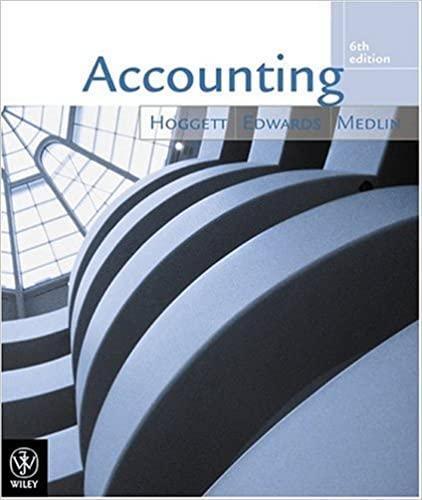Question
Bronson Shrimp Farms, in Brewton, Alabama, has a Processing Department that processes raw shrimp into two products: Headless shrimp Peeled and deveined shrimp Bronson recently
Bronson Shrimp Farms, in Brewton, Alabama, has a Processing Department that processes raw shrimp into two products:
Headless shrimp
Peeled and deveined shrimp
Bronson recently submitted bids for two orders (1) headless shrimp for a cruise line and (2) peeled and deveined shrimp for a restaurant chain. Bronson won the first bid but lost the second. The production and sales managers are upset. They believe that Bronsons state-of-the-art equipment should have given the company an edge in the peeled and deveined market. Consequently, production managers are starting to keep their own sets of product cost records. Bronson is reexamining both its production process and its costing system. The existing costing system has been in place since 1991. It allocates all indirect costs based on direct labor hours. Bronson is considering adopting activity-based costing. Controller Heather Barefield and a team of production managers performed a preliminary study. The team identified six activities, with the following estimated indirect costs and allocation bases for the Processing Department for 2014:
| Activity | Estimated Total Cost of Activity | Allocation Base |
| Redesigning of production process (cost of changing process and equipment) | $ 5,000 | Number of design changes |
| Production scheduling (production scheduler salary) | 6,000 | Number of batches |
| Chilling (depreciation on refrigerators) | 1,500 | Weight in pounds |
| Processing (utilities and depreciation on equipment | 19,200 | Number of cuts |
| Packaging (indirect labor and depreciation on equipment) | 1,425 | Cubic feet of surface exposed |
| Order filling (order takers and shipping clerks wages) | 7,000 | Number of sales orders |
| Total indirect costs for the entire department | 40,125 |
|
The raw shrimp are chilled and then cut. For headless shrimp, employees remove the heads, then rinse the shrimp. For peeled and deveined shrimp, the headless shrimp are further processed the shells are removed and the backs are slit for deveining. Both headless shrimp and peeled and deveined shrimp are packaged in foam trays and covered with shrink wrap. Order-filling personnel assemble orders of headless shrimp as well as peeled and deveined shrimp.
Barefield estimates that Bronson will produce 10,000 packages of headless shrimp and 50,000 packages of peeled and deveined shrimp in 2014. The two products incur the following costs and activities per package
|
| Costs and activities per package | |
|
| Headless shrimp | Peeled and deveined shrimp |
| Shrimp | $ 3.50 | $ 4.50 |
| Foam Trays | $ 0.05 | $ 0.05 |
| Shrink wrap | $ 0.05 | $ 0.02 |
| Number of cuts | 1 cut | 3 cuts |
| Cubic feet of exposed surface | 1 cubic foot | 0.75 cubic foot |
| Weight | 2.5 pounds | 1 pound |
| Direct labor hours | 0.01 hour | 0.05 hour |
Bronson pays direct laborers $20 per hour. Barefield estimates that each product line also will require the following total resources:
|
| Headless shrimp (for all 10,000 packages) | Peeled and deveined shrimp (for all 50,000 packages) |
| Design changes | 1 change | 4 changes |
| Batches | 40 batches | 20 batches |
| Sales orders | 90 orders | 110 orders |
1. Using the original costing system with the single indirect cost allocation base (direct labor hours), compute the total budgeted cost per package for the headless shrimp and then for the peeled and deveined shrimp. Round to two decimal places. (Hint: First, compute the predetermined overhead allocation rate. Then compute the total budgeted cost per package for each product.
2. Use activity-based costing to re-compute the total budgeted cost per package for the headless shrimp and then for the peeled and veined shrimp Round to two decimal places. (Hint: First, compute the predetermined overhead allocation rate for each activity. Then calculate the total indirect costs for (a) the entire headless shrimp product line and (b) the entire peeled and deveined shrimp product line. Next, compute the indirect cost per package for each product. Finally, calculate the total cost per package for each product)
3. Write a memo to Bronson CEO Gary Pololu explaining the results of the ABC study. Compare the costs reported by the ABC system with the costs reported by the original system. Point out whether the ABC system shifted costs towards headless shrimp or toward peeled and deveined shrimp and explain why.
Finally, explain whether Pololu should feel more comfortable making decisions using cost data from the original or from the new ABC system.
Step by Step Solution
There are 3 Steps involved in it
Step: 1

Get Instant Access to Expert-Tailored Solutions
See step-by-step solutions with expert insights and AI powered tools for academic success
Step: 2

Step: 3

Ace Your Homework with AI
Get the answers you need in no time with our AI-driven, step-by-step assistance
Get Started


